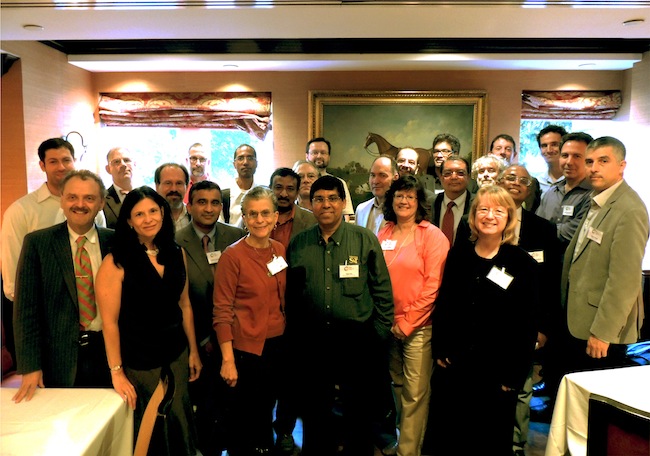Congress Won’t Finish Appropriations or COMPETES Authorization this Year
Computing Researchers Come to DC to Make Case for Computing
Despite hopes at the beginning of the year of Congress returning to regular order with regard to appropriation bills, the body has slide back into its old form of passing stopgap Continuing Resolutions (CR) to fund governmental operations. The good news is both chambers learned their lesson from last year and will not play chicken with a shutdown of the government — or at least, not before they stand before the voters in the November midterm elections.
The House passed the current CR on Wednesday September 17th and by the Senate the next day, followed quickly by the President’s signature on September 19th. It will fund the government at Fiscal Year (FY) 2014 levels through December 11th, with the expectation that Congress will return before then and pass an omnibus bill containing funding language for all twelve individual appropriation bills. From a good governance standpoint, both Appropriations committees want to take care of FY15 this calendar year because the expectation is that there will be no time next year to handle two fiscal year appropriations. However a more important element in the calculus is who wins control of the Senate in the midterm elections.
Should the Senate be won by the Republican Party in November, there is a very good chance that Congress will punt approval of the FY15 appropriations bills to early 2016, when the party will control both chambers of Congress. If the Democrats retain control of the Senate, the likelihood of FY15 being settled in December, when Congress returns for its lame duck session, is much more likely, as it will be the same power dynamic in 2015 calendar year as it is now.
From the perspective of the science research community broadly, and computing research specifically, we are being caught up in larger political issues once again. It’s unclear at this time how the science agencies, such as the National Science Foundation, would fare in an omnibus funding bill. While NSF did relatively well in the House (where appropriators approved a 3.3 percent increase), Senate appropriators would only fund the agency at the level of the President’s request (1.2 percent increase. So where an omnibus bill would fall is an open question at this time; it could split the difference, or it could go to the higher or lower number.
FIRST Act and COMPETES Act Reauthorization
As you will recall from our previous coverage, the House Science, Space and Technology Committee majority’s attempt to reauthorize the America COMPETES Act of 2010 – which provided increases in authorizations for NSF, the National Institute of Standards and Technology and the Department of Energy’s Office of Science, as well as bolstering a number of Federal STEM Education programs – met with disappointment from the science advocacy community. The bill suffered from lackluster funding authorizations, over-reaching open access provisions, and problematic language in the name of “enhancing NSF accountability.” As a result, the bill was stridently opposed by the committee Democrats and looked to be headed for a somewhat bitterly-partisan approval. Fortunately, a desire to work together prevailed on the committee, and non-contentious sections of the FIRST Act were stripped out to form stand-alone bills in the hope of getting something passed this Congress.
Computer science was one of the first beneficiaries of this new approach: H.R. 5031, the “STEM Education Act of 2014.” This bill is made of three parts (it is actually a very short bill). The first part, which is of most importance to the CS community, is the explicit inclusion of Computer Science in the definition of “STEM education.” The inclusion of CS in STEM is aimed at ensuring that CS won’t get left out of future STEM Ed initiatives at the Federal level (at least at NSF, NASA, NOAA, Energy, and NIST…the agencies under the jurisdiction of the Science Committee). The bill also authorizes STEM agencies to fund research that advances the field of informal STEM education and expands the NSF Noyce Scholarship Program to include awardees with bachelor’s degrees (currently only people with master degrees qualify) and provide funding authorization to support NSF Master Teacher Fellows for a year. All three of these provisions are largely bipartisan and funding neutral. HR 5031 was passed by the full House chamber in early July and is now awaiting action in Senate.
The other bills introduced are:
* HR 5035 — A bill to reauthorize the National Institute of Standards and Technology, and for other purposes.
* HR 5056 — A bill to improve the efficiency of Federal research and development, and for other purposes.
* HR 5029 — A bill to provide for the establishment of a body to identify and coordinate international science and technology cooperation that can strengthen the domestic science and technology enterprise and support United States foreign policy goals.
All are non-controversial. HR 5056 sounds ominous, given “NSF accountability” language in FIRST, but it’s just a bill calling on OSTP to put together a working group to study how to “harmonize, streamline, and eliminate duplicative Federal regulations and reporting requirements, and minimize the regulatory burden on US institutions of higher education performing federally funded research while maintaining accountability for Federal tax dollars.” All of the above bills were passed by the full House chamber and are awaiting action in the Senate.
On the Senate side, at the end of July the Senate Commerce, Science, and Transportation Committee finally released the American COMPETES Reauthorization Act of 2014 (S. 2757). This is the long awaited Senate Democrat response to the FIRST Act. The hope was that this bill would be a true reauthorization of the original America COMPETES Act of 2007 and be bipartisan in nature.
The language of the bill is excellent: three years of appropriations, with healthy funding increases, for NSF, NIST, and DOE SC (FIRST Act only had two years, one being FY14, the then present fiscal year); strong support for peer review research and the way the science agencies are choosing what research is funded; and strong support for STEM education. It can be said this bill was a clear sign of support for the science agencies and the scientific community.
Unfortunately, the bipartisan support did not materialize: we received word in early September that the Commerce Committee was shelving plans to bring the bill up for a vote because it would have passed on a party line vote, with no Republican support. To give some perspective, the original COMPETES Act, in 2007, and it’s first reauthorization in 2010, passed the Senate on voice votes with no opposition. This means that reauthorizing COMPETES in this Congress is dead, as there is no more time on the Congressional schedule for it to be considered.
It is likely COMPETES will return in the 114th Congress, though in what form is still an open question. However, the likelihood is that science will continue to be used as a political messaging weapon by both parties. In short, expect something more like the FIRST Acts and less like a COMPETES reauthorization in the next Congress.
The CRA Government Affairs Office will continue to monitor this situation for developments. Be sure to check the CRA Policy Blog for more updates: cra.org/govaffairs/blog
Computing Researchers Fly-in to DC to Make the Case for Computing
On September 17th, over two dozen computing researchers from across the country came to Washington to make the case before Congress for federally supported computing research. The 27 volunteers, coming from as near as Maryland and New Jersey, and as far away as Utah and Kansas, participated in 60 House and Senate meetings on Wednesday September 17th. Their message to Congress was very simple: federally supported computing research is vital to the nation’s future. Using their own research and individual stories as support, and armed with additional information from CRA, they made the “Federal case” for computing to Members of Congress and their staff. Just as important as the message they carried, they also made connections with those who represent them in DC. Those Members now know a little about the expertise and interesting (and important) work that goes on in their districts and states, and our participants have a sense of just who represents them in Congress — and they’ve hopefully created a lasting dialogue on both sides.
As a reminder, if you would like to participate in a future Congressional Visit Day, or if you are in Washington and would like to visit your representative’s office, contact Brian Mosley (bmosley@cra.org) in the CRA Government Affairs Office. CRA can provide expert training, messaging, and materials, and we would be happy to accompany you on your meetings as well.
2014 Congressional Visit Day Participants










